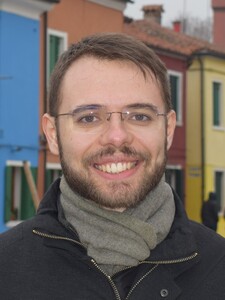Lucas Sá

Dr Lucas Sá
1851 Research Fellow
Postdoc in Prof Béri's group
Office: 504 Mott Bld
Email: ld710 @ cam.ac.uk
Google Scholar
TCM Group, Cavendish Laboratory
19 JJ Thomson Avenue,
Cambridge, CB3 0HE UK.
Research
Understanding far-from-equilibrium and/or open quantum systems when they have many strongly-interacting constituents is an enormous challenge, but one with immense potential rewards. Solutions exist for certain low-dimensional exactly-solvable (also known as integrable) models. An alternative approach, inspired by random-matrix theories of quantum chaos, is to replace complex systems with simple toy models possessing the main features of interest. The Sachdev-Ye-Kitaev (SYK) model (a toy model of infinitely strongly-coupled electrons) and quantum circuits (minimal, quantum-computer-realisable, models of strongly-interacting time evolution), for instance, have been very successful.
I apply a blend of quantum chaos, many-body quantum theory, and nonequilibrium field theory to investigate the interplay of order and chaos with dissipation and nonequilibrium conditions. My research, at the intersection of condensed matter, quantum information, and high-energy physics, focuses on the quantum chaos approach to the nonequilibrium and open realms, with excursions into quantum integrability and high-energy physics. It revolves around the following overarching questions: (i) How to study (exactly or statistically) the dynamics of far-from-equilibrium strongly-interacting quantum systems? (ii) What are the universal properties of complex dissipative quantum matter? (iii) How to define, detect, and quantify quantum chaos in the presence of dissipation?
In Plain English
The butterfly effect is a well-known manifestation of chaos: a butterfly flapping its wings in Brazil could set off a tornado in Texas. In the quantum world of microscopic particles, the uncertainty and complexity of outcomes are embodied by the observation that complicated quantum systems with many particles behave as if they were random. Indeed, often the only realistic approach to theoretically study these systems is to forgo a detailed exact description and search for signatures of universal behavior shared by collections of many distinct, yet sufficiently similar, systems. Quantum chaos provides a powerful statistical framework for addressing this question, relying on symmetries to obtain information not accessible otherwise. It applies to systems as diverse as heavy nuclei, quantum computers, and black holes.
Until recently, the theory of quantum chaos still missed a key ingredient: openness. No physical system is truly isolated from its environment (be it an experimental apparatus or the rest of the universe), and their interaction has dramatic consequences, such as dissipation (loss of energy by the system) or decoherence (loss of its very quantum nature). Openness can be a hindrance, e.g., for quantum computation, with dissipation and decoherence limiting the accuracy current quantum computers. Or it can be a resource, as in atomic and mesoscopic physics, where experimental advances now allow us to engineer special states of matter based on dissipation.
In my research, I examine how to reconcile chaos and dissipation in strongly interacting quantum systems, a newly flourishing field known as dissipative quantum chaos. This growing field has allowed us, for instance, to better understand how current-day noisy quantum computers operate, yet many exciting questions remain: how to use dissipation and strong interactions to induce transitions from order to chaos and prepare special states of matter? What are the best tools to distinguish dissipative order from chaos? And why does dissipative quantum chaos work in the first place?
Featured Publications
Full list of publications available on my arXiv and Google Scholar pages.